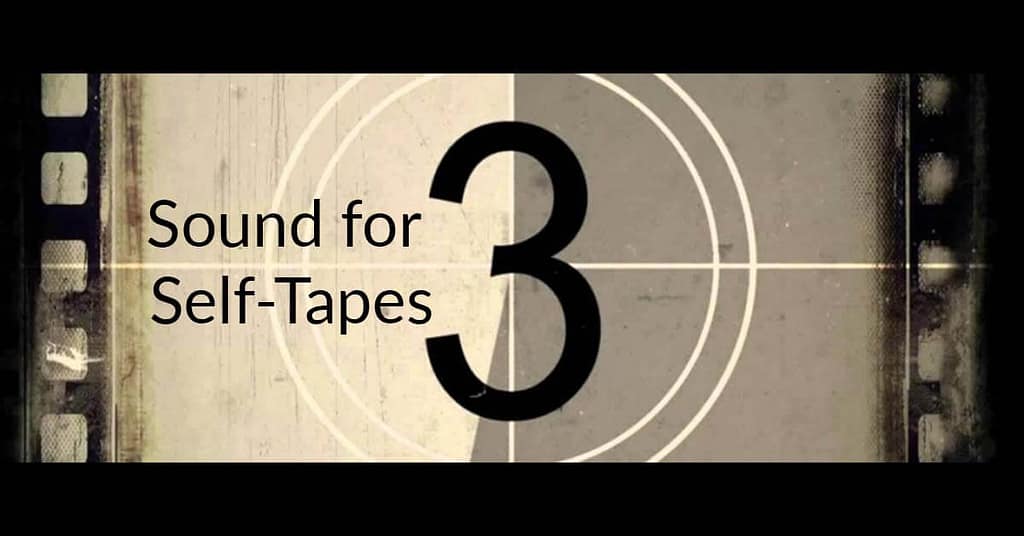#TechniqueTuesday – Great Sound for Your Tapes!
For actors in today’s world, it’s all about self-tapes. And that means putting your best foot forward no matter where your self-tape is headed. That includes doing your best acting, looking great, having great lighting, and let us not forget – HAVING GREAT SOUND! No matter if you are submitting something for Baz Luhrmann’s next project or just posting on #MonologuesMondays, make sure your tape is absolutely top quality. Because you never know who’s going to watch it. And because first impressions are something you can NEVER take back.
Don’t rush it, take the time to set up your taping space. Take your time to learn the lines and make strong choices. Shoot it until you’re really proud of it. Make sure you edit it up to industry standards – are they doing fade ins/fade outs? Slate before or after? Also make sure you follow the slating instructions to the T. They want to see if you can follow directions! That’s super important when you’re on set.
And SOUND. Sound is something that gets overlooked a lot but it’s super important. It will really put your tape into the “pro” or the “not-so-pro” pile. To get great sound this is what I recommend:
1. First and foremost – make sure there is no background sound, cars honking, a fan overhead, dog barking next door, static, etc. This can be a challenge but it’s SUPER important. The last thing you want to do is pull the audience out of the scene and distracting background noise will do that. So if you don’t have a quiet place to shoot, find one or make one. Even arrange to go to someone else’s place if you have to. Maybe shoot at a time when it’s quieter, nighttime, early morning. You can put up blankets to dampen the sound or shoot in a walk-in closet banked by hanging clothes. Figure it out. It’s important.
2. Use a mic – Purchase a lav mic and use it. Most of them can plug right into your phone. Clip it to yourself or on a mic stand or even on your tripod that is holding your camera. Make sure it is no more than a few feet away from you. Mics can be pricy but there are several relatively inexpensive ones that are designed just for this very kind of thing. My favorite is: BOYA by-M1 Microphone – $25.00 (https://www.boya-mic.com/wap/lavaliermicrophones/1259.html)
3. Sound levels – Make sure your reader isn’t too loud or too quiet. Or you’re not too loud or too quiet. I just recently watched an audition tape where you couldn’t hear the reader at all, and it was so frustrating and confusing that you didn’t even care about the actor’s performance. For a casting director that would be a total skip. We DO NOT WHAT THAT TO HAPPEN EVER!
4. Speak clearly – Don’t over articulate but make sure your words are clear. You may need voice and speech training. I recommend Lessac Kinesensics (https://www.lessacinstitute.org). If you have a strong accent, make sure you can be understood. Work with a dialect coach. Accents can be tricky. If you are submitting work, unless they ask for a specific accent, they expect you to be able to do the accent of the market you’re in. If it’s American English, that’s the accent you should use. If it’s a Spanish, or British or Japanese market you need to sound like you fit right in. That doesn’t mean your accent or your native language is not valid or beautiful – you just need to have strong accent management so you can match the accent or dialect for the market you want to work in.
5. And lastly – Make sure your sound is synched. Sometimes audio and video can get unsynced which will be very distracting and look really silly—your mouth moving in front or behind of the sound. This should rarely if at all happen to your footage and if it does it’s an easy fix in most editing programs. Just be aware of it.
In the video above I made two examples – A. What NOT to do with sound. And B. A good example of great sound quality. Take a look and see the difference!
You’ve got this! Just make sure you do your best. It will pay off.
If you have any questions email us at info@actorsinactionconservatory.com or visit our website: www.actorsinactionconservatory.com

